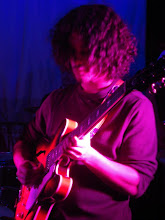Once we’re on the topic of teaching, I’d like to point out something that should seem obvious yet also seems to not be reflected in much of jazz education. I’d also like to note right away that this ties into the free jazz conversation dating back to my first blog entry and much thanks to my free jazz guru, Mitch Haupers. The skill of improvisation and listening is a skill which is distinct and separate from the acquisition of a musical vocabulary. But when we improvise, you ask quite rightly, don’t we use a vocabulary? How can you possibly mean that? Well, improvising means to me having a message and a distinct logic in the way ideas are put together in a sequence. In a way this article is not so different from improvisation. I know where I want to be at the end and I know where I’m starting but I have not mapped out how I will proceed in the middle. Yet inside I can feel intuitively that all the points are there and that I can have this discussion logically. Now, I could write this article in French or Italian or Chinese or Hindu or any other language (if I actually knew any of them well enough) but the content would remain the same and my methodology in the way I go about creating my story, my point, my thought process, would also remain the same.
With that said, I find it strange that most beginning jazz students are introduced to the art of improvisation at the same time they are introduced to the vocabulary of jazz, which happens to be more complicated than some other available vocabularies. As I mentioned in my last article, I discuss with student’s in the context of simple songs, triadic in nature with slow moving harmonic progressions, or even pedals, how to create a complex interaction between the different components of music (i.e. using multiple skills at the same time). This might mean playing a continuous melody which involves two or three closed positions and transitioning between them using the skill of playing on one string. This might involve working triadic arpeggios or chordal gestures into our melodic playing or embellishing triads using the knowledge we have acquired through the playing on one string or in closed position. This whole idea of synthesizing concepts which were originally introduced as separate and unrelated lies at the heart of improvisation, in my opinion. If a young student can master complex ideas with a simple vocabulary, to extend these ideas to a more complicated vocabulary will come much more naturally to them. Why are they trying to solo using fourths or chord substitutions or drop 2 voicings if they can’t even solo using triads?
The study that follows serves two purposes for two different skill levels. The first group is the maturing student who I was just describing. They will be pushed to analyze the piece and name all the notes on the neck of the guitar and in doing so they will build stronger fundamentals and have an easier time playing closed positions triads. Although they probably will never play open triads anytime soon, it will be a good exercise to help them with their closed triads. For this reason, tabs have been included.
Oh, I forgot. This exercise is about open triads. A sound which I find very interesting and particularly beautiful on the lower five strings of the guitar. I have already spent much time exploring the possibilities of triads in this blog as either vehicles for melodic inventions or chord substitutions. Perhaps in working on open triads I might unlock new possibilities in both these areas. And just like my students, I think it would be good to start with something simple just to get started. Naturally, since this exercise is much less mind-blowing for an advanced jazz musician than a young and inexperienced rock musician, it should be transposed into all twelve keys.
Subscribe to:
Post Comments (Atom)


No comments:
Post a Comment